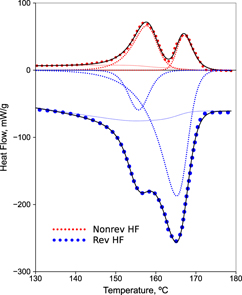Crossref Citations
This article has been cited by the following publications. This list is generated based on data provided by
Crossref.
López-Beceiro, Jorge
Gracia-Fernández, Carlos
and
Artiaga, Ramón
2013.
A kinetic model that fits nicely isothermal and non-isothermal bulk crystallizations of polymers from the melt.
European Polymer Journal,
Vol. 49,
Issue. 8,
p.
2233.
Vargas-Villagran, H.
Romo-Uribe, A.
Teran-Salgado, E.
Dominguez-Diaz, M.
and
Flores, A.
2014.
Electrospun polylactic acid non-woven mats incorporating silver nanoparticles.
Polymer Bulletin,
Vol. 71,
Issue. 9,
p.
2437.
Gracia-Fernández, C. A.
Gómez-Barreiro, S.
Álvarez-García, A.
López-Beceiro, J.
Álvarez-García, B.
Zaragoza-Fernández, S.
and
Artiaga, R.
2014.
Thermal characterization of poly-l-lactide by dielectric analysis and modulated DSC.
Journal of Thermal Analysis and Calorimetry,
Vol. 116,
Issue. 3,
p.
1273.
Salehiyan, Reza
Ray, Suprakas Sinha
and
Ojijo, Vincent
2018.
Processing‐Driven Morphology Development and Crystallization Behavior of Immiscible Polylactide/Poly(Vinylidene Fluoride) Blends.
Macromolecular Materials and Engineering,
Vol. 303,
Issue. 10,
Shyr
Ko
and
Chen
2019.
Homocrystallization and Stereocomplex Crystallization Behaviors of As-Spun and Hot-Drawn Poly(l-lactide)/Poly(d-lactide) Blended Fibers During Heating.
Polymers,
Vol. 11,
Issue. 9,
p.
1502.
Itzinger, Regina
Schwarzinger, Clemens
and
Paulik, Christian
2020.
Investigation of the influence of impurities on the ring-opening polymerisation of L-Lactide from biogenous feedstock.
Journal of Polymer Research,
Vol. 27,
Issue. 12,
Staub, Mark C.
Li, Ruipeng
Fukuto, Masafumi
and
Li, Christopher Y.
2020.
Confined Crystal Melting in Edgeless Poly(l-lactic acid) Crystalsomes.
ACS Macro Letters,
Vol. 9,
Issue. 12,
p.
1773.
Mapossa, António
López-Beceiro, Jorge
Díaz-Díaz, Ana
Artiaga, Ramón
Moyo, Dennis
Mphateng, Thabang
and
Focke, Walter
2021.
Properties of Mosquito Repellent-Plasticized Poly(lactic acid) Strands.
Molecules,
Vol. 26,
Issue. 19,
p.
5890.
Noivoil, Narumol
and
Yoksan, Rangrong
2021.
Compatibility improvement of poly(lactic acid)/thermoplastic starch blown films using acetylated starch.
Journal of Applied Polymer Science,
Vol. 138,
Issue. 2,
Díaz-Díaz, Ana María
López-Beceiro, Jorge
Li, Yanchun
Cheng, Yi
and
Artiaga, Ramón
2021.
Crystallization kinetics of a commercial poly(lactic acid) based on characteristic crystallization time and optimal crystallization temperature.
Journal of Thermal Analysis and Calorimetry,
Vol. 145,
Issue. 6,
p.
3125.
Mishra, Suvrajyoti
Sahoo, Rajesh
Unnikrishnan, Lakshmi
Ramadoss, Ananthakumar
Mohanty, Smita
and
Nayak, Sanjay Kumar
2021.
Enhanced structural and dielectric behaviour of PVDF-PLA binary polymeric blend system.
Materials Today Communications,
Vol. 26,
Issue. ,
p.
101958.
Mystiridou, Emmanouela
Patsidis, Anastasios C.
and
Bouropoulos, Nikolaos
2021.
Development and Characterization of 3D Printed Multifunctional Bioscaffolds Based on PLA/PCL/HAp/BaTiO3 Composites.
Applied Sciences,
Vol. 11,
Issue. 9,
p.
4253.
Zhou, Chenmeng
and
Zhang, Xuzhen
2021.
Preparation and Properties of Acetylated Cellulose Nanocrystals/Poly(butylene succinate-co-butylene adipate) Composites.
Journal of Macromolecular Science, Part B,
Vol. 60,
Issue. 2,
p.
99.
Peixoto, Tânia
Carneiro, Sofia
Fangueiro, Raúl
Guedes, Rui M.
Paiva, Maria C.
and
Lopes, Maria A.
2022.
Engineering hybrid textile braids for tendon and ligament repair application.
Journal of Applied Polymer Science,
Vol. 139,
Issue. 17,
Balakrishnan, Naveen Kumar
Siebert, Stefan
Richter, Christoph
Groten, Robert
and
Seide, Gunnar
2022.
Effect of Colorants and Process Parameters on the Properties of Dope-Dyed Polylactic Acid Multifilament Yarns.
Polymers,
Vol. 14,
Issue. 22,
p.
5021.
Yakdoumi, Fatima Zohra
Hadj-Hamou, Assia Siham
Rahoui, Nahla
Rahman, Md Mushfequr
and
Abetz, Volker
2022.
Polylactic acid nanocomposites containing functionalized multiwalled carbon nanotubes as antimicrobial packaging materials.
International Journal of Biological Macromolecules,
Vol. 213,
Issue. ,
p.
55.
Perin, Davide
Fredi, Giulia
Rigotti, Daniele
Soccio, Michelina
Lotti, Nadia
and
Dorigato, Andrea
2022.
Sustainable textile fibers of bioderived polylactide/poly(pentamethylene 2,5‐furanoate) blends.
Journal of Applied Polymer Science,
Vol. 139,
Issue. 10,
Pawłowska, Alona
Stepczyńska, Magdalena
and
Walczak, Maciej
2022.
Flax fibres modified with a natural plant agent used as a reinforcement for the polylactide-based biocomposites.
Industrial Crops and Products,
Vol. 184,
Issue. ,
p.
115061.
Agustin-Salazar, Sarai
Ricciulli, Marco
Ambrogi, Veronica
Cerruti, Pierfrancesco
and
Scarinzi, Gennaro
2022.
Thermomechanical Properties and Biodegradation Behavior of Itaconic Anhydride-Grafted PLA/Pecan Nutshell Biocomposites.
Polymers,
Vol. 14,
Issue. 24,
p.
5532.
Zhou, Yuyang
Wang, Xiaoyu
Li, Yening
Wang, Wenxin
Gilchrist, Michael D.
and
Zhang, Nan
2022.
Toward the Scalable Fabrication of Fully Bio-Based Antimicrobial and UVB-Blocking Transparent Polylactic Acid Films That Incorporate Natural Coatings and Nanopatterns.
ACS Applied Materials & Interfaces,
Vol. 14,
Issue. 48,
p.
54338.





